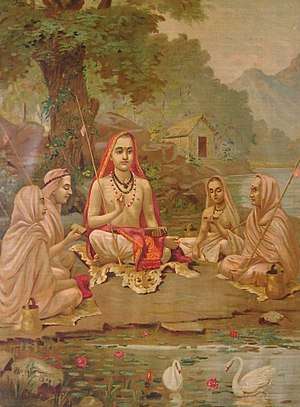Shankaracharya
| Shankaracharya | |
|---|---|
 Jagadguru Adi Shankaracharya with his four disciples - Padmapadacharya, Sureshwaracharya, Hastamalakacharya & Totakacharya | |
| Religion | Hinduism |
The four main Shankaracharya Mathas/Peethas are listed in the following table. shankaracharya was born in kaladi near kerala. His father name is Shivaguru and his mother Aryamba. He was born to Brahmin family. His teacher was Govind Bhagavatpada
| # | Peethas/Mathas | Location | Founder Acharya | Present Shankaracharya |
|---|---|---|---|---|
| 1 | Govardhan Peetham | East Puri, Odisha | Shri Padmapadacharya (Padmapada) | Swami Shri Nischalananda Saraswati g |
| 2 | Dwarka Sharada Peetham | West Dwarka, Gujarat | Shri Hastamalakacharya (Hastamalaka) | Swami Shri Swaroopananda Saraswati |
| 3 | Jyotirmath Peetham | North Jyotirmath, Badrikashram, Uttarakhand | Shri Totakacharya (Totaka) | Swaroopananda Saraswati |
| 4 | Sringeri Sharada Peetham | South Sringeri, Karnataka | Shri Sureshwaracharya (Sureshwara) | Shri Bharati Tirtha Mahaswami |
| 5 | Kanchi Kamakoti Peetam | South.
Kanchipuram, Tamil Nadu |
Sarvajnataman | Shri Vijayendra Saraswati Swamigal |
Shankaracharya (IAST: Śaṅkarācārya, Shankara acharya) is a commonly used title of heads of monasteries called mathas in the Advaita Vedanta tradition. The title derives from Adi Shankara, an 8th-century AD reformer of Hinduism.[1] He is honored as Jagadguru, a title that was used earlier only to Krishna.
The popular view among historians is that there were four Mathas or Peethas (religious orders):
- The Dakshiānmnāya Sri Sharada Peetham (Main Matha) or the Shri Sringeri Sharada Peetham in Sringeri, Karnataka.
- The Uttarāmnāya matha (Northern Matha) or the Jyotirmath Peetham in the city of Jyotirmath, Badrikashram also known as Joshimath, Uttarakhand.
- The Pūrvāmnāya matha (Eastern Matha), or the Govardhan Peetham at Puri, Odisha.
- The Paśchimāmnāya matha (Western Matha), or the Dwarka Sharada Peetham at Dwarka, Gujarat.
It is believed that after establishing the above four mathas and appointing his four disciples as head of these mathas, Adi Shankara established a fifth matha at Kanchipuram and became the head of that matha till his life time.[2] This fifth matha is called Kanchi Kamakoti Peetham
The table below gives an overview of the four Amnaya Mathas founded by Adi Shankara, and their details.[3]
| Shishya (lineage) |
Direction | Maṭha | Mahāvākya | Veda | Sampradaya |
|---|---|---|---|---|---|
| Padmapāda | East | Govardhana Pīṭhaṃ | Prajñānam brahma (Consciousness is Brahman) | Rig Veda | Bhogavala |
| Sureśvara | South | Sringeri Śārada Pīṭhaṃ | Aham brahmāsmi (I am Brahman) | Yajur Veda | Bhūrivala |
| Hastāmalakācārya | West | Dvāraka Pīṭhaṃ | Tattvamasi (That thou art) | Sama Veda | Kitavala |
| Toṭakācārya | North | Jyotirmaṭha Pīṭhaṃ | Ayamātmā brahma (This Atman is Brahman) | Atharva Veda | Nandavala |
Shankaracharya is also seen as an avatar of Shiva (Shankara). Shankaracharya is responsible for founding many punyakshetras along the length and breadth of India, by taming avatars of Parvati and imprisoning her essence in Sri Chakras.
Adi Shankaracharya wished to grace the Indian subcontinent by establishing four major mathas in the four corners of the peninsula – north (Jyothirmath), south (Sringeri), east (Puri), west (Dwaraka) – to propagate the philosophy of advaita vedanta and to promulgate the concept of Sanatana dharma, thus establishing dharma or righteousness, as the way of life of people. His primary four disciples took charges of each math and thus established a strong Guru-Sishya parampara (a lineage of masters-disciples) in every math, that continues to guide people to this day.
Further reading
- Mukhyananda, Swami (2006) Sri Shankaracharya: life and philosophy: An elucidative and reconciliatory interpretation, 4th ed.; OCLC 426914596; Kolkata; Advaita Ashrama
- Esoteric Buddhism by A.P. Sinnett, pp 81 ISBN 1438503652
See also
- Adi Shankara
- Kalady, Kerala - the holy birth place of Jagadguru Adi Shankaracharya
- Govardhan Peetham (East), Puri, Odisha
- Dwarka Sharada Peetham (West), Dwarka, Gujarat
- Jyotirmath Peetham (North), Jyotirmath, Badrikashram, Uttarakhand
- Shri Sringeri Sharada Peetham (South), Sringeri, Karnataka
- Shri Kanchi Kamakoti Peetham, Kancheepuram, Tamil Nadu
- Jagadguru of Sringeri Sharada Peetham
- Swāmī Abhinava Vidyā Tīrtha, Śaṅkarācārya of Śṛṅgeri
- Swāmī Bhāratī Tīrtha, Śaṅkarācārya of Śṛṅgeri
- Swāmī Bhāratīkṛṣṇa Tīrtha, scholar; mathematician; first Śaṅkarācārya to visit the West
- Swāmī Brahmānanda Sarasvatī, Śrīvidyā siddha; Śaṅkarācārya of Jyotirmāyā Pīṭha, Śaṅkara Matha, Badrināth
- Swāmī Swarupānanda Sarasvatī; Śaṅkarācārya of Jyotirmāyā Pīṭha, Śaṅkara Matha, Badrināth
- Swāmī Candrasekhara Bhāratī, Śaṅkarācārya of Śṛṅgeri
- Swāmī Saccidānanda Bhāratī, Śaṅkarācārya of Śṛṅgeri
- Swāmī Saccidānanda Bhāratī, Śaṅkarācārya of Śṛṅgeri
- Swāmī Saccidānanda Śivābhinava Nṛsiṁha Bhāratī, Śaṅkarācārya of Śṛṅgeri
- Swāmī Vidyāraṇya Tīrtha, Śaṅkarācārya of Śṛṅgeri
- Jagadguru of Ramachandrapura Matha - Sri Sri Raghaveshwara Bharati
- Jagadguru of Swarnavalli Matha - Gangadharendra Saraswati Swamiji
References
- ↑ Aditya Thakur (1 November 2014). "Just A Handful Of Hindus Know Adi Shankaracharya Revived Their Religion". Topyaps. Retrieved 16 May 2014.
- ↑ http://www.kamakoti.org/kamakoti/details/Shankaracharya-Kanchipuram%20Home.html
- ↑ "Adi Shankara's four Amnaya Peethams". Archived from the original on 26 June 2006. Retrieved 2006-08-20.
External links
| Wikimedia Commons has media related to Shankaracharyas. |